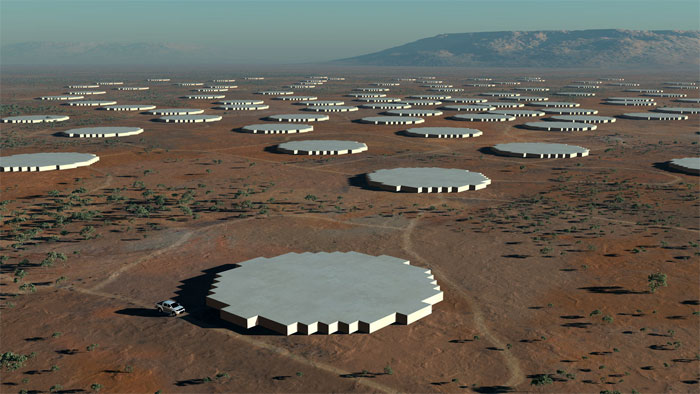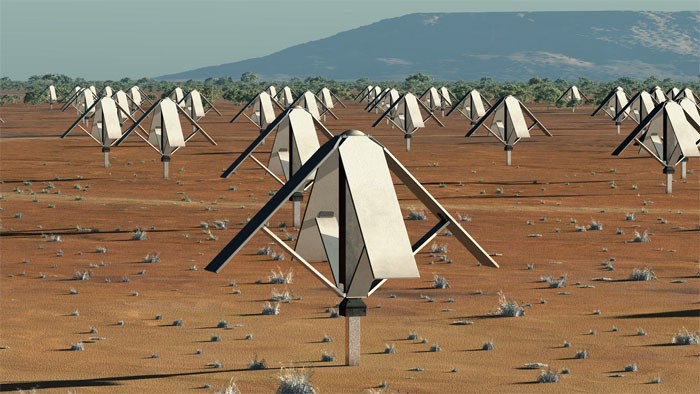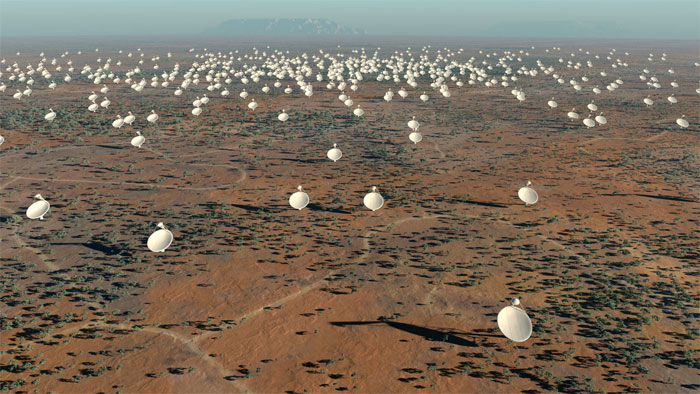Germany’s science funding may look healthy to outsiders, but its research ministry seems to have stretched its cash too thinly. Last week, it decided that helping to fund the world’s biggest radio telescope — to be built in South Africa and Australia by 2024 at a cost of more than €1.5 billion (US$2 billion) — was one international mega-project too many. On 5 June, it said it would pull out of the Square Kilometre Array (SKA), to the dismay of German astronomers, who say that they were not consulted and are hoping to reverse the move.
“It looks like Germany is in danger of derailing one of Africa’s first really big science projects,” says Michael Kramer, the director of the Max Planck Institute for radioastronomy in Bonn. From the SKA’s point of view, however, a loss of German support (which might have amounted to tens of millions of euros to an estimated €650-million first construction phase) would be “disappointing, but not catastrophic”, says Philip Diamond, director-general of the SKA Organization, headquartered in Manchester, UK, which coordinates the efforts of ten supporting nations. Nonetheless, says Diamond, “I and my German colleagues are working hard to do what we can to overturn this decision”.
The SKA is named for the total collecting area of its 3,000 15-metre-wide radio dishes, most of them to be built in South Africa, with some dishes and hundreds of thousands more simple antennas in Australia. Astronomers are meeting in Sicily, Italy, this week to discuss research plans for the mega-project, which would capture radiowave emissions from the Universe going back to when the first stars were born, a few hundred million years after the Big Bang. The organizers boast that the telescope will be able to detect a television signal from a planet circling a star tens of light years away, should any aliens be broadcasting.
From the science perspective, Germany is a major player in the project, says Kramer. At this week’s meeting, an updated SKA ‘science book’ — a comprehensive discussion of key science projects — was released; and in the tally of the national affiliations of lead authors contributing to each chapter, Germany comes in third. “We estimate a community of about 400 people actively interested in supporting the SKA,” Kramer says. Kramer himself leads an effort to detect gravitational waves from radio observations of pulsars, a project that he says has in part driven the design of the telescope.
But in funding terms, it was a lesser light. Germany had not yet negotiated its share of the €650 million first construction phase of the SKA beginning in 2017–18, which would involve adding more than 100 dishes to existing facilities — MeerKAT in South Africa, and the SKA Pathfinder in Australia. South Africa and Australia have already put hundreds of millions of euros into these precursor telescopes, but only the United Kingdom has so far definitely pledged future cash, of £100 million (US$168 million). Germany would have been expected to pay in a little less than that, says Diamond.
“The withdrawal is not such a huge reversal as you might think,” adds John Womersley, a particle physicist who chaired the now disbanded founding board of the SKA. Germany’s science ministry (the BMBF) is trying hard to stretch its budget across a number of large European projects expected to open in the next few years, he notes, including the European X-ray free-electron laser (XFEL) project in Hamburg (to produce X-rays from 2017), an international accelerator for antiprotons and ions (FAIR) in Darmstadt (providing beams of ions from 2018), and the European Spallation Source in Lund, Sweden (shooting out powerful neutrons from 2019). “The impact of finite budgets is being felt in those projects,” he says.
In Germany, however, astronomers are unhappy. “The decision has apparently been made internally in the ministry, without any consultation with the astronomy community,” says Kramer, who was talking to Nature from the sidelines of the Italian conference. If Germany did pull out, then its scientists would lose most of their time with the telescope, he says, because only a very small percentage of international time will be allowed for research from nations who didn’t contribute to funding. German industry would also lose out, since it would not be able to win contracts for the telescope’s construction. “I have heard from colleagues that other ministries are also shocked and surprised by the decision, and some are hesitating about what to do,” he adds.
Still, none of this indicates an international loss of confidence in the SKA project, emphasize Kramer, Diamond and Womersley. In a statement on its website, the SKA Organization said that it understood the pull-out was “driven by difficult national financial circumstances around the funding of large research infrastructures in Germany and Europe and that it by no means reflects a lack of confidence in the SKA project” — a statement South African science minister Naledi Pandor emphasized in her response to the announcement. Pandor, who called the decision “regrettable”, will set up a meeting with her German counterpart to discuss the issue in the next few weeks, according to a statement from the South African science ministry.
There is still time to change the German ministry’s mind: its commitments run out on 30 June 2015, under current legal agreements. But “they present this as a pretty final decision,” Womersley says.
The ministry did not yet reply to requests for comments (today is a national holiday in Germany).
Quelle: nature
.
Germany Announces Its Intent To Leave The SKA Organisation
On Thursday 5th of June, 2014, in an official letter signed by Dr. Georg Schütte, the State Secretary of BMBF, the German federal science ministry, Germany officially informed the SKA Director-General of its intent to leave the SKA Organisation.
Under the current legal agreements signed by both parties, Germany’s membership of SKA Organisation will thus end on June 30, 2015.
SKA Organisation regrets this decision, and understands it is driven by difficult national financial circumstances around the funding of large research infrastructures in Germany and Europe and that it by no means reflects a lack of confidence in the SKA project.
While this is disappointing news, the decision to leave SKA Organisation in a year’s time will have no immediate consequences on the project due to the limited German federal funding that has been issued so far. Involvement from German institutions, industry and scientists in the SKA’s science working groups and in design work through the design consortia is unlikely to be affected in the short-term. However, as the project enters its construction phase in 2017/18 German industry will be most affected by this decision, as it will no longer be in a position to bid for major engineering contracts to be awarded for construction of the SKA. In addition, following the recent Board approval of the SKA Access Principles, the ability of the German science community to use the telescope will be compromised.
The SKA has been hailed as the world’s next big science project after the Large Hadron Collider and the International Space Station. It will bring together thousands of scientists and engineers to tackle the immense engineering challenges behind building the world’s largest radio telescope, with clear spinoffs in data storage and transport, signal processing, new developments in computing and many more. Investment in research and innovation and participation in major international collaborations is beneficial to the national economies involved, stimulating growth, and supporting highly-qualified local employment.
To date, over 120 million euros have been invested in 20 countries to support some 500 scientists and engineers working on designing the SKA. In March of this year, the UK was the first country to announce a firm commitment of £100M for SKA construction; this is in addition to the hundreds of millions of euros already provided by the two SKA host countries, Australia and South Africa, in building the SKA precursors: ASKAP, MWA and MeerKAT.
SKA Organisation will continue to work alongside colleagues from the German scientific community and industry. German scientists in particular play a strong role in defining and advancing the science to be done with SKA.
It is the hope of the Organisation that the financial climate will improve sufficiently in the coming year for the German Ministry of Science to reconsider its decision.
Quelle: SKA
.
Update: 14.06.2014
.
Germany set to pull out of €2bn radio telescope
.
The head of the €2bn Square Kilometre Array (SKA) is confident that the project will go ahead, despite Germany saying that it will pull out of the project in 12 months' time. In a press conference held in Sicily today, where more than 250 radio astronomers gathered to discuss the project, SKA director-general Philip Diamond reiterated that the withdrawal would not have a "long-term effect" on what will be the world's largest radio telescope when built in 2023 in Australia and southern Africa.
Progress was also made at the meeting on drawing together the 130 chapters that will make up the updated SKA "science book", which will be released by the end of this year. Appearing 10 years after the previous version was published, the new SKA science book will set the direction of what will be the world's most sensitive radio telescope. Germany was the third largest contributor to the publication, behind Italy and the UK.
Germany's decision to withdraw was announced last week following a letter sent last month by Georg Schütte, the state secretary of the Germany's federal science ministry (BMBF), to SKA director-general Philip Diamond. The letter informed SKA officials that Germany's membership would end on 30 June 2015 – only two years after it first joined the organization. The BMBF took the decision because it is apparently under financial pressure as it has to find money for two large German-based projects – the X-ray Free Electron Laser in Hamburg and the Facility for Anti-Proton Research in Darmstadt.
This has come completely out of the blue. It will have a catastrophic impact on German astronomy
Michael Kramer, director of the Max Planck Institute for Radio Astronomy in Bonn
"We're obviously disappointed by Germany's decision," Diamond told Physics World. Although he says that the withdrawal will not have a major impact on the project "in the near future", Germany's decision has caused some concern among researchers. Germany had been expected to contribute towards the SKA's construction and had already spent around €1m on a membership fee and contributed around €2.8m towards the €140m cost of the SKA's design. Moreover, the move to pull out was apparently taken without consultation with the astronomy community. "This has come completely out of the blue," says Michael Kramer, director of the Max Planck Institute for Radio Astronomy in Bonn. "It will have a catastrophic impact on German astronomy."
Germany has already played a major role in determining what science the SKA will do, with the German radio-astronomy community having been involved in a number of science working groups to define this. "German industry is involved in some of the design work too," adds Diamond.
Extreme sensitivity
Germany is currently the 10th full member of the SKA Organisation, which includes researchers from Australia, Canada, China, Italy and South Africa working together to build a giant facility in the form of more than 3000 antennae with a total collecting area of one million square metres spread across Australia and southern Africa. The main site in South Africa is in the Karoo semi-desert region more than 500 km north-east of Cape Town, while most of the Australia antennae will be in the Murchison region, more than 300 km from the nearest town, Geraldton, on the country's west coast.
Construction of the first phase of the project is scheduled to begin in 2018. It will see an array of 254 dishes built in South Africa covering the bulk of the high- and mid-frequencies of the radio spectrum, while Australia will host the low-frequency section of the array with 96 dishes accompanied by approximately 250,000 individual dipole antennas. Astronomers will use the telescope to probe the early universe by looking as far back into time as the first 100 million years after the Big Bang. It will also search for life and planets, as well as study the nature of dark energy.
Design work for the first phase of the SKA got under way in 2013 and one of the key aims for 2014–2016 is to secure funding for the construction of the array. If all goes to plan, the first science results will appear from 2020 onwards, with the first phase of the array scheduled to be fully complete in 2023. Construction is scheduled to begin on phase two of the telescope in 2023 and is due to be finished by 2030.
Knock-on effect
The SKA Organisation will now have to manage Germany's withdrawal, including finding other partners to pay for what the country might have contributed towards construction. Construction costs have yet to be divided between member states, but estimates – as a starting point to negotiations – show Germany would have been set to pay about 10–12% of the total. "That makes this decision to pull out even more baffling, as we don't yet know how much Germany would have needed to pay," says Kramer, who adds that his institute will continue to contribute to the SKA.
However, Diamond is hopeful that if Germany does not backtrack, then other countries could step into its shoes. "There are a number of other countries actively interested in joining the SKA, and we expect to see more in the next few years as we ramp up our funding search, which we've only just started," says Diamond. But he thinks the real losers in the withdrawal will be German industry, which will not now be able to compete for engineering contracts to build the SKA, as well as the German science community, which will now find it harder to get time on the telescope. "That's unfortunate given Germany's long tradition of radio astronomy," adds Diamond. "But interest in SKA science is strong in Germany, and we believe the German scientific community will continue to work with us, and we will support them in that."
Quelle: physicsworld
.
Update: 25.01.2015
.
Probing the Universe with the Square Kilometre Array

Scientists from South Africa are playing a leading role in developing the science which will be done with the world's largest telescope, the Square Kilometre Array.
The SKA telescope, to be built in Australia and South Africa, will allow scientists to look far back into the history of the universe and will give much more detail than before on how the universe has evolved over 14 thousand million years. More information will be obtained on how stars, galaxies and clusters of galaxies formed and how they have changed since the Universe was young. This will allow for the plotting of a 3D map of the Universe.
The international SKA Organisation, which includes eleven countries, is bringing up to date the science case for the telescope. South African scientists are playing a leading role in many of the working groups. The SKA Cosmology Working Group is chaired by Roy Maartens, SKA Research Professor at the University of the Western Cape (UWC). Professor Maartens and Professor Mario Santos, also a Research Professor at UWC, with astronomers from South Africa and the other SKA member countries, have played a leading role in setting out the SKA science.
Roy Maartens says: "Researchers here have devised a means of using the world's largest telescope in new ways that will help shape the future of cosmology."
Mario Santos says: "Usually a map of the Universe is made using galaxies as tiny beacons of the large scale structure of the Universe. This is quite demanding as it requires the mapping of large numbers of galaxies across the sky."
"The survey we are proposing will measure the emitted radiation from all the hydrogen atoms spread across the Universe without actually detecting galaxies. This will make it easier to survey all of the sky across cosmic times, allowing the phase 1 of the SKA to become an extremely competitive cosmology machine," he adds.
"By making these huge, 3D maps of the Universe we will be able to test the limits of General Relativity and maybe find some signature of new physics on these large scales which can shed light on the true nature of dark energy. Moreover, we can also look for imprints of what happened at the very beginning of the Universe," added Santos.
An experiment like this, says Santos, using intensity mapping, has never been done before. The largest 3D maps of the large scale structure of the Universe have been done using optical telescopes. The current project will be about 50 times larger. Other future experiments, such as the Euclid satellite, will be able to also probe a large fraction of the Universe, but none will match the SKA in terms of size and depth.
Maartens adds: "It will be like making a movie of the Universe from a young age, when it was only about 2 billion years old, until today when it is about 14 billion years old. The movie will be low resolution but enough to test the fundamentals of cosmology."
When the actual survey with the SKA comes online, a large team will be required to deal with it. Once the phase 1 of the SKA is built, around 2023, it will take about 2 years to complete the survey.
SKA SA has been crucial in promoting the build up of the required researchers to lead such an effort. However, says Santos, they don't have to wait for the SKA to start, before doing observations. "Tests are already being conducted using the KAT7 system with the full support of the KAT7 staff and we plan to start tests with MeerKAT in just a year, during the early science phase," Santos stated.
He added that the SKA telescope is like a "physics lab", allowing many different experiments to be pursued. There will be other surveys that in combination with this one, will allow scientists to push the limits of our current knowledge of the Universe.
-
Quelle: SKA
Fotos von SKA Aufbau:
-
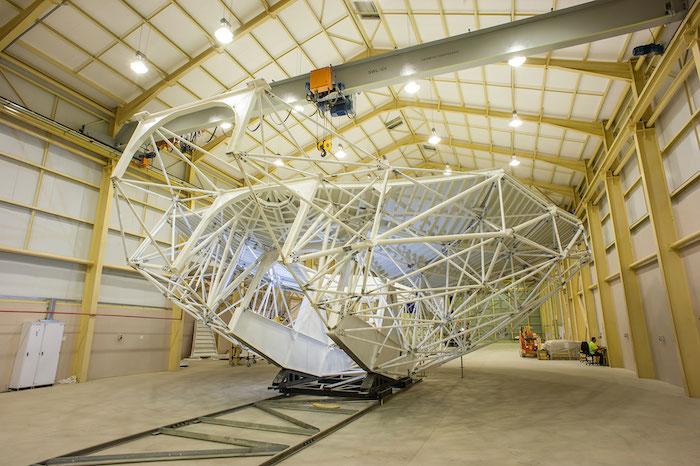
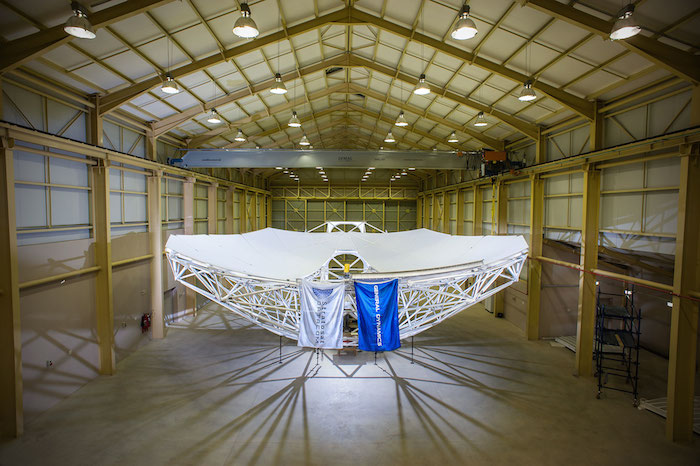
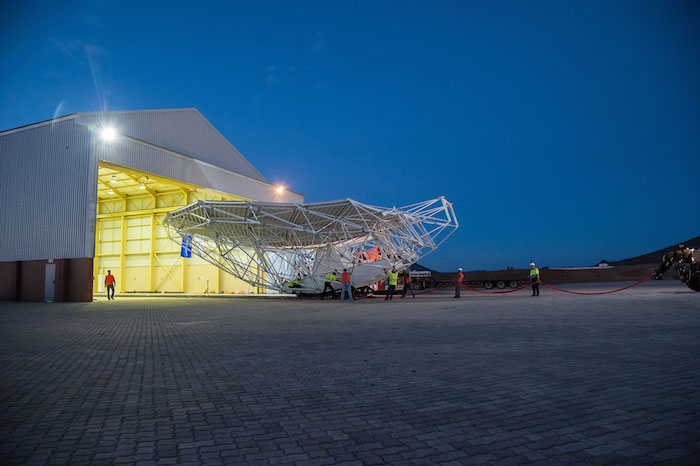
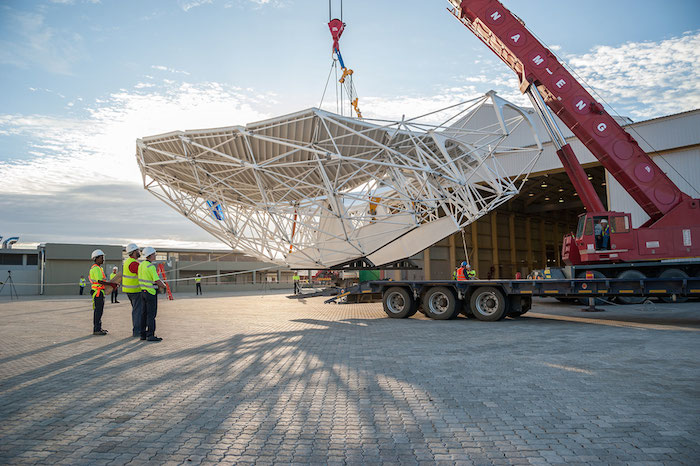
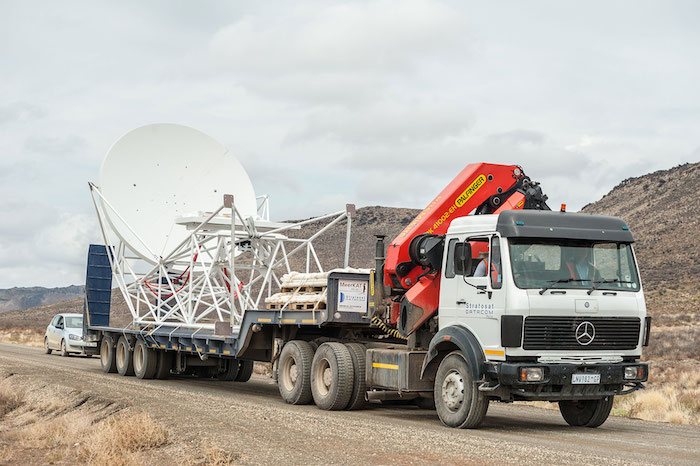
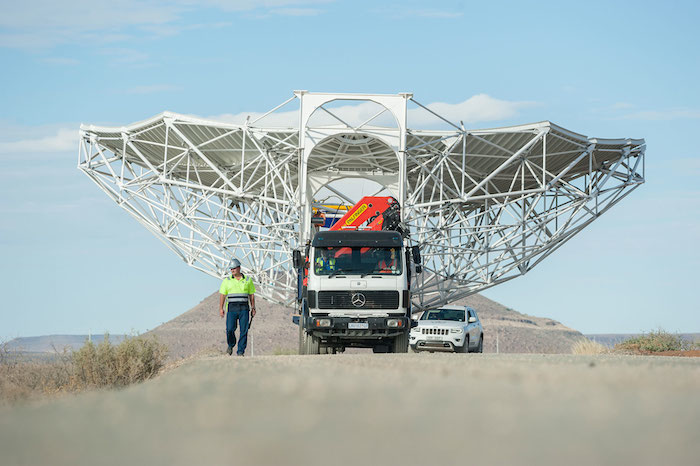
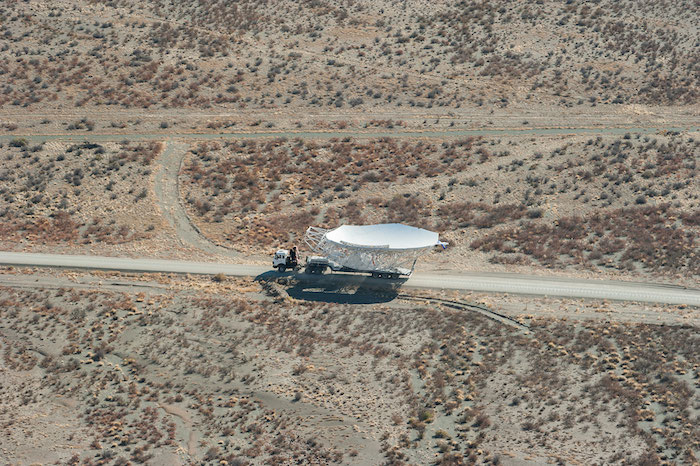
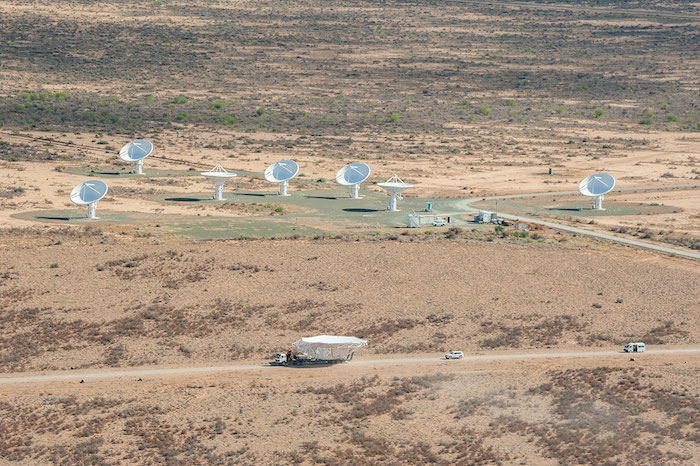
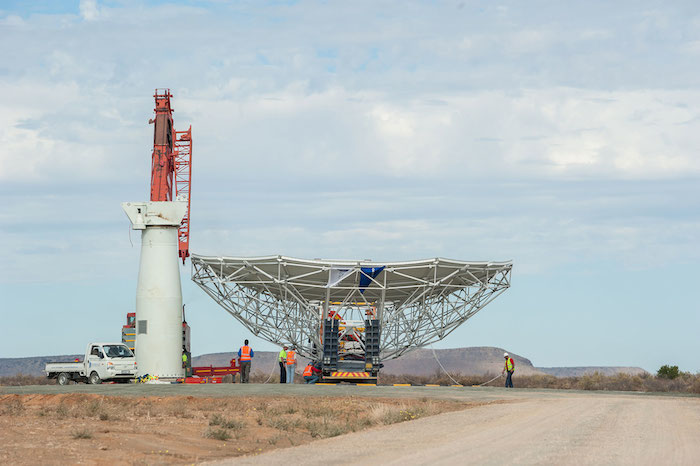
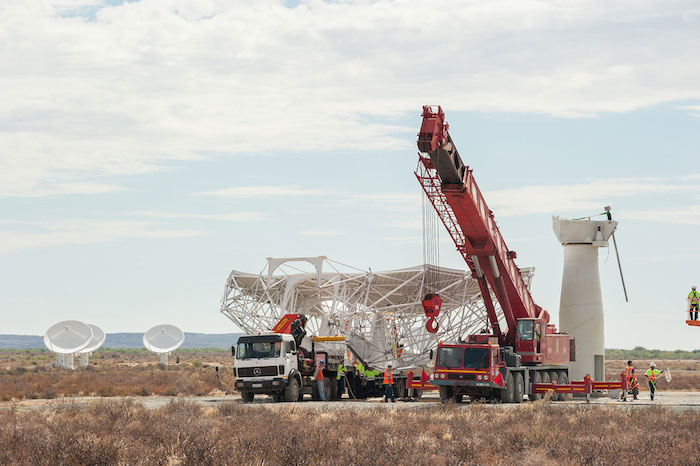
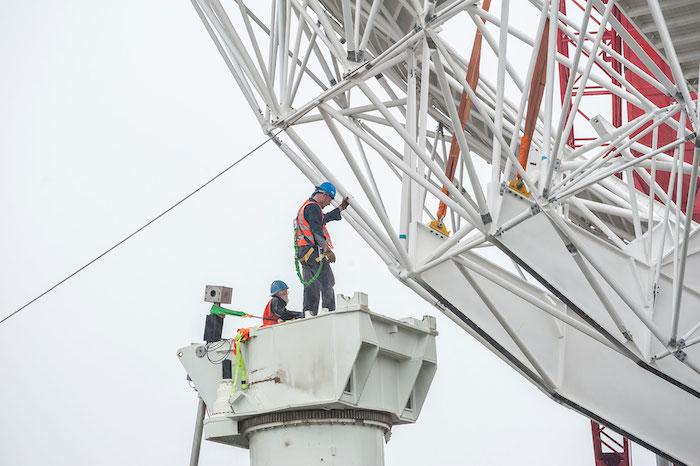
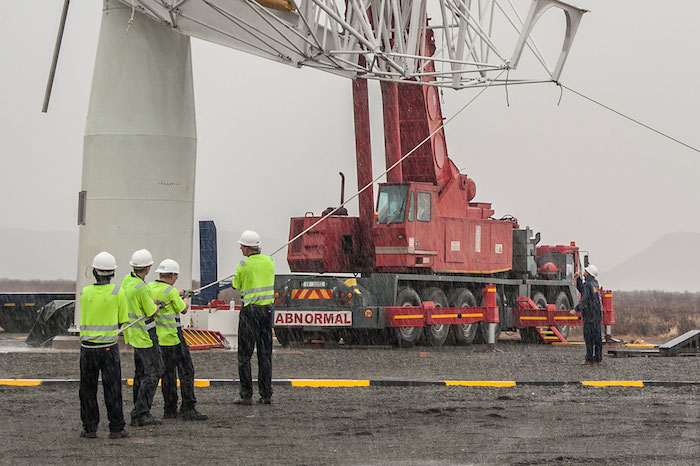
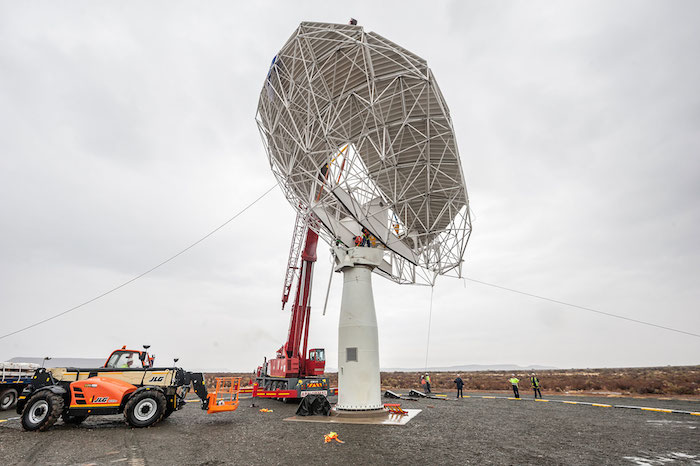
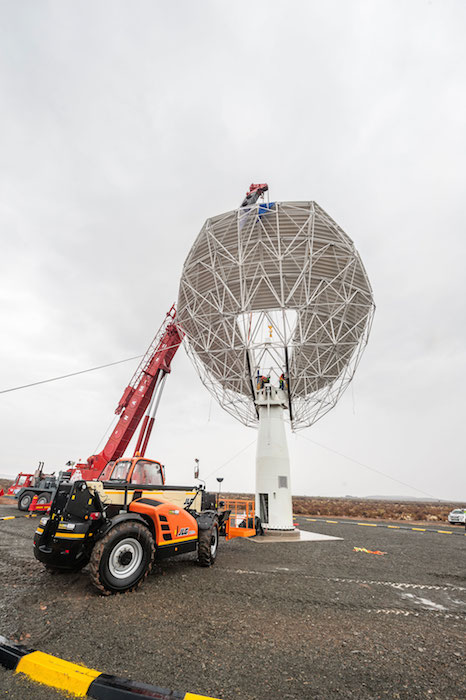
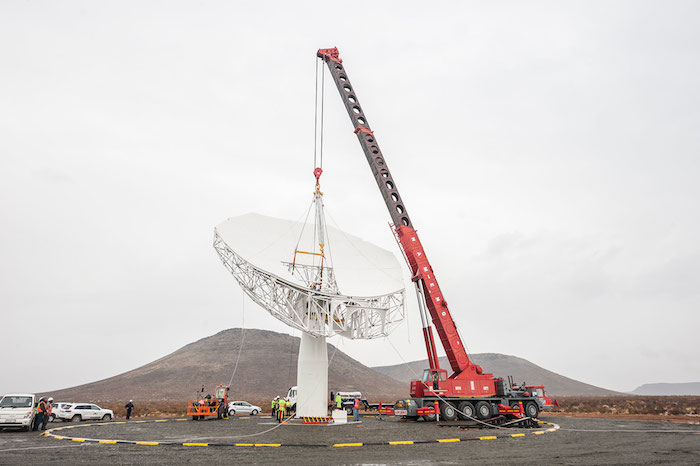
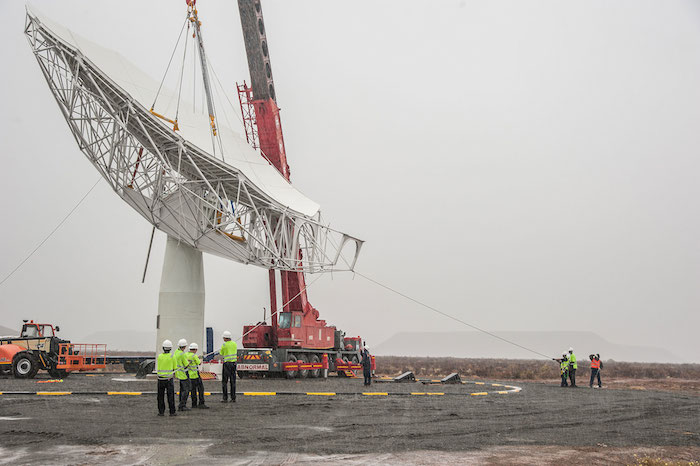
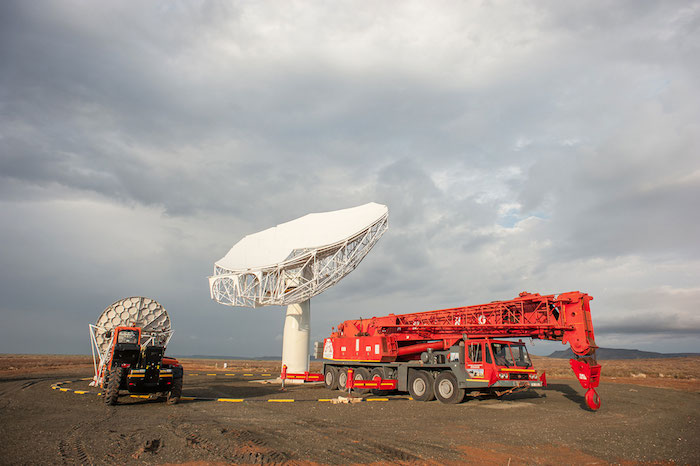
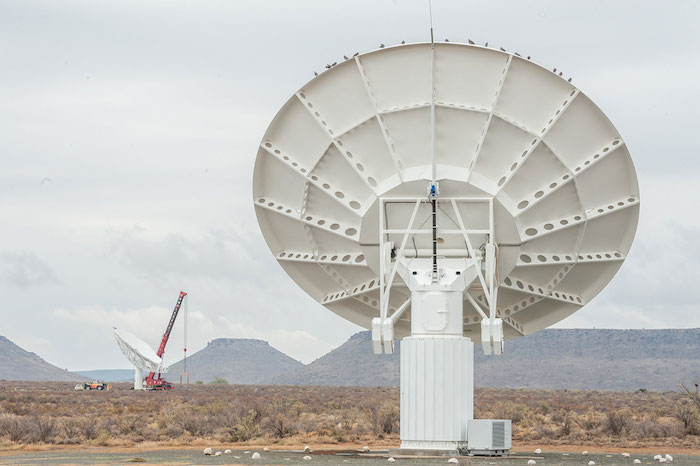
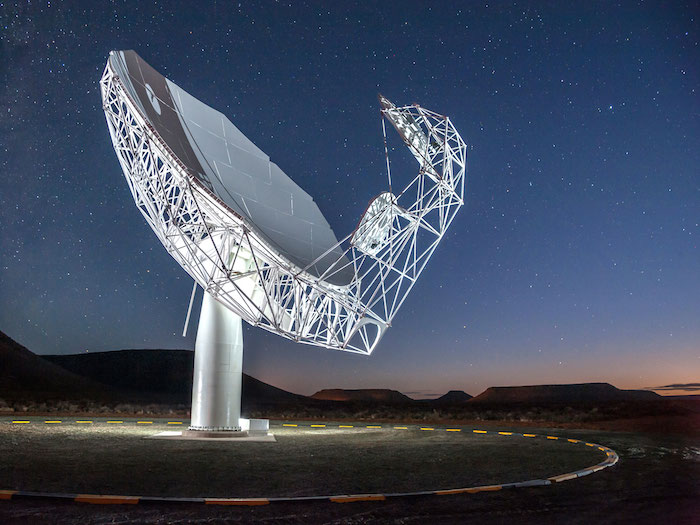
Fotos: SKA South Africa
-
Square Kilometre Array: Die Kosmologie-Maschine
Astronomen wollen mit dem größten Radioteleskop aller Zeiten das Universum kartieren
Ein internationales Team von Wissenschaftlern, darunter Hans-Rainer Klöckner vom Max-Planck-Institut für Radioastronomie in Bonn und Dominik Schwarz von der Universität Bielefeld, hat sich zusammengetan, um die Grundsteine zu Experimenten astronomischen Ausmaßes zu legen. Dabei wollen sie die größte Kartierung des Universums erstellen. Dieser Himmelsatlas, generiert durch die Kombination der Radiosignale von Hunderten von Radioteleskopen, wird einen Großteil des Universums abdecken und somit eine Vielzahl von neuartigen Experimenten ermöglichen. Die Experimente, die sich mit einer derart gigantischen Himmelsdurchmusterung durchführen lassen, sind heute in einer Serie von Abhandlungen auf dem astronomischen Preprint-Server „arXiv.org“ veröffentlicht worden.
Die internationale Arbeitsgruppe des Square Kilometre Array (SKA) für Kosmologie hat erstmals Konzepte entwickelt, wie das größte Teleskop der Welt Schlüsselfragen der Kosmologie beantworten kann. „Das Team hat eine beachtliche Leistung vollbracht und eine Vielzahl von Ideen und Experimenten entwickelt, die die Kosmologie in Zukunft beeinflussen werden“, sagt der Vorsitzende der Arbeitsgruppe, Roy Maartens, von der Universität Western Cape, Südafrika.
Das SKA wird in zwei Bauabschnitten (Phase 1 und Phase 2) durch unterschiedliche Antennenfelder realisiert. In der ersten Phase wird das SKA aus einer locker besetzten Anordnung von Parabolspiegeln in Südafrika und einfachen Antennen in Australien bestehen. In Phase 2 wird eine deutlich höhere Anzahl dieser Einzelteleskope und Antennenelemente und eine dritte Komponente von Empfängerelementen installiert und somit die Empfindlichkeit des SKA erheblich erhöht.
Nach Abschluß der ersten Bauphase im Jahr 2023 wird das SKA eine Sammelfläche von 15 Fußballfeldern besitzen und wird an einem Betriebstag ein Datenvolumen verarbeitet können, das den heutigen Datenverkehr des globalen Internets um ein Vielfaches überschreitet. Die zweite Bauphase des SKA wird voraussichtlich Ende der 2020er Jahre abgeschlossen sein.
Ein wichtiger Schlüssel zum Kosmos ist die Vermessung des Radiosignals des neutralen Wasserstoffs (HI). „Neutraler Wasserstoff ist das am häufigsten vorkommende Element im Universum und wir können es zu jedem Zeitpunkt in der Entwicklungsgeschichte des Universums messen“, sagt Phil Bull von der Universität Oslo in Norwegen. „Es ist ein idealer Indikator, der uns erlaubt, die Materieverteilung auf großen Skalen zu verfolgen.“ Zusätzlich kann der Effekt der Dunklen Materie auf HI- Galaxien gemessen werden, der ansonsten durch kein Teleskop beobachtbar ist.
Welche Faktoren beeinflussen die Kartierung des Kosmos: Genauigkeit oder Beobachtungsgeschwindigkeit
Die dreidimensionale Kartierung von Galaxien ist im Allgemeinen sehr aufwändig und man benötigt lange Beobachtungszeiten, um die individuellen Eigenschaften zu messen und um den neutralen Wasserstoff zur kosmischen Entfernungsbestimmung nutzen zu können. Diese Methode ist die bisher genauste und man erwartet, bis Ende der 2020er Jahre mit einer Milliarde HI-Galaxien eine detaillierte 3-dimensionale Karte der Masseverteilung des Universum darstellen zu können. Im Vergleich zu heutigen Galaxienkatalogen, die rund eine Millionen Galaxien beinhalten, ist das eine Verbesserung um drei Größenordnungen.
Eine vielversprechende Alternative ist ein von SKA-Wissenschaftlern entwickelter Beobachtungstrick, um die Masseverteilung im Universum zu messen. Hierbei beobachtet man nicht individuelle Galaxien, sondern fährt („scannt“) mit dem Teleskop ganze Himmelsbereiche ab. Diese Methode reduziert die Winkelauflösung stark, aber es lassen sich dadurch größere Bereiche in kürzester Zeit beobachten.
“Diese Beobachtungsmethode liefert uns nur Bilder mit geringer Winkelauflösung“, sagt Mario Santos von der Universität Western Cape in Südafrika, „aber die Beobachtungen ermöglichen es uns, Rückschlüsse zur Geometrie des Universum und zur Natur der Gravitation zu ziehen.“ Erste Ergebnisse eines solchen Experiments lassen sich bereits für 2022 erwarten.
Ein neues Fenster zu kosmischen Mysterien
Eines der größten Geheimnisse der Kosmologie ist die Natur der Dunklen Energie. Diese hypothetisch eingeführte Form der Energie erlaubt es, die beschleunigte Ausdehnung des Universum zu erklären. „Mit dem SKA wird man Präzisionskosmologie machen können und der Natur des Dunklen Energie auf den Zahn fühlen“, sagt Alvise Raccanelli von der Johns-Hopkins-Universität in Baltimore, USA. „Wir sind ferner in der Lage, durch die 3-dimensionale Vermessung der Galaxien Einsteins Allgemeine Relativitätstheorie zu überprüfen.“ Hierbei erlauben die charakteristischen Muster der Galaxienverteilung eine Präzisionsmessung der Ausdehnung und Entwicklung des Universums über Milliarden von Jahren.
Die Beobachtung von weit entfernten Galaxien erlaubt detaillierte Einblicke in die Entwicklungsgeschichte des Universums, aber es ist nicht nur der Blick in die Vergangenheit, der hilft, das Universum zu verstehen. “Wir können die Ausdehnung des Universums in Echtzeit messen. Dazu beobachten wir das HI-Signal von Milliarden von Galaxien über eine Zeitspanne von 10 Jahren.“, sagt Hans-Rainer Klöckner vom Max-Planck-Institut für Radioastronomie in Bonn. „Die kosmologische Ausdehnung ist relativ gering im Vergleich mit unserer Lebenszeit und es ist ein technischer Meilenstein, aber eine direkte Messung ist möglich. Sie erlaubt es, kosmologische Modelle zu prüfen und eine Charakterisierung der Dunklen Energie zu erstellen“, sagt Klöckner.
„Die Allgemeine Relativitätstheorie Einsteins zu prüfen, ist ein erklärtes Ziel der Kosmologen. Die Ergebnisse werden uns zeigen, ob es eine fünfte fundamentale Wechselwirkung gibt“, sagt Gongbo Zhao vom National Astronomical Observatory aus China. „Eine Entdeckung, dass die Theorie auf kosmologischen Skalen versagt, würde unsere Vorstellung von Raum und Zeit auf den Kopf stellen.“
Diese gigantische Himmelsdurchmusterung der sichtbaren Materie wird eine Tür zu einem neuen Arbeitsgebiet aufschließen, nämlich die Erforschung der ersten Momente nach den Urknall. „Erkenntnisse auf ultragroßen Skalen erlauben uns Rückschlüsse auf das neugeborene Universum nur Sekunden nach dem Big Bang.“, sagt Stefano Camera vom Jodrell Bank Centre for Astrophysics in Manchester, England. Diese Messungen werden die Inflationstheorie testen und zu einem besseren Verständnis der Bildung von Galaxien und Super-Clustern in der Entstehungsgeschichte des Universum führen.
Die Geometrie des Universums
Das SKA wird nicht nur aus der dreidimensionalen Verteilung von Wasserstoffgalaxien bahnbrechende Erkenntnisse liefern, es werden auch neue Entdeckungen aus der zweidimensionalen Verteilung aller radioemittierenden Galaxien erwartet. „Diese Kataloge werden Hunderte von Millionen von Galaxien in Phase 1 und sogar mehrere Milliarden von Galaxien in Phase 2 des SKA beinhalten und somit erlauben, die Geometrie des Universums zu testen“, sagt Matt Jarvis von der Oxford-Universität in England.
Die Experimente, die auf der Basis solcher Kataloge durchgeführt werden, ermöglichen die Überprüfung von fundamentalen physikalischen Prinzipien, die letztendlich bis zu Copernicus im 16. Jahrhundert zurückgehen. Sie besagen, dass die Materieverteilung im Kosmos im gleichförmig sein sollte, unabhängig von der Blickrichtung des Teleskops („statistische Isotropie“). Aber das muss ja nicht für immer gelten. „Wenn die Messungen da etwas anderes ergeben, hätte das sehr ernste Auswirkungen auf unser gesamtes Verständnis des Universums“, schließt Dominik Schwarz von der Universität Bielefeld.
Zusätzliche Veröffentlichungen:
Neben den Artikeln zur Kosmologie sind eine Reihe von Artikeln zu den Bereichen “Schwerkraft und Vorstellungen von Raum und Zeit” sowie “Kosmischer Magnetismus” erschienen, an denen ebenfalls Mitarbeiter von Max-Planck-Instituten und deutschen Universitäten beteiligt waren. Sie sind ebenfalls auf dem Preprint-Server „astro-ph“ zugänglich. Insgesamt werden 130 Artikel im Sommer 2015 von der SKA-Organisation in Buchform veröffentlicht.
Quelle: MPI-München
.
Update: 10.03.2015
.
Square Kilometer Array scales back ambitions for first phase
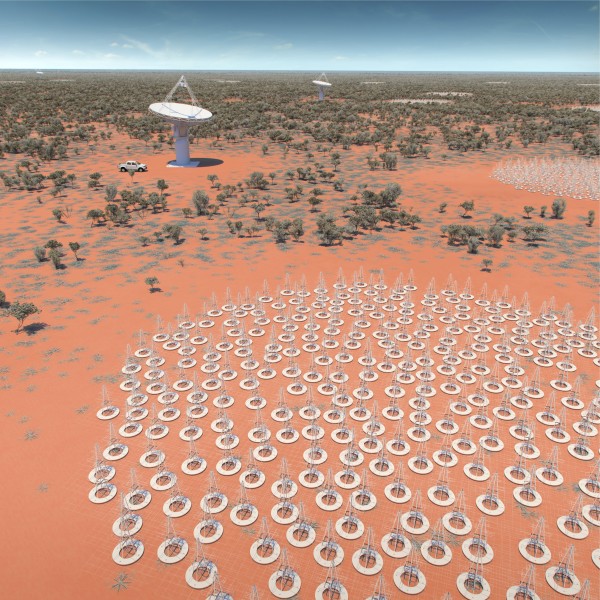
Dipole antennas (like wireframe Christmas trees) of the Square Kilometer Array's proposed low-frequency telescope in Australia.
The consortium that will build the world’s biggest radio telescope, the Square Kilometer Array (SKA), today announced the final scope of the first phase of the project, which is due to begin construction in 2018 and be completed by 2023. Although it has had to be scaled back to stay within the available funding, the project will still be able to achieve all of its key scientific goals.
“You have to make compromises when you are cutting your cloth to the funding you’ve got,” says SKA director Philip Diamond. “There is a scaling down, but it is still a highly transformational instrument,” says astrophysicist Philip Best of the University of Edinburgh’s Institute of Astronomy.
SKA, funded by 11 countries from around the globe, will be built partly in Southern Africa and partly in Australia. The plan is to first build a pilot instrument which, as well as advancing astronomy itself, will also prove that the principle behind the giant telescope actually works before the construction of phase 2 between 2023 and 2030. The final instrument will have dishes and antennas stretching across most of Africa as well as Australia and will have a total collecting area of a square kilometer.
A baseline design for SKA was drawn up during the planning stage, and teams in South Africa and Australia are in the process of building two prototype arrays to test some of the technology: the 36-dish Australian SKA Pathfinder (ASKAP) and the 64-dish MeerKAT array in South Africa.
In July 2013, the SKA board set a cost cap for phase 1, also called SKA1, of €650 million. Since then there has been a worldwide effort by working groups and advisory boards to see what was possible within that budget. “We pulled it all together last October so that we could understand the costs to deliver the science goals,” Diamond says.
The final plan for SKA1, announced today, has two components. The first is a mid-frequency array with about 200 dish antennas in South Africa that will incorporate MeerKAT—down from roughly 250 in the original baseline plan. The second part is a low-frequency array in Australia which will be made up of about 130,000 so-called dipole antennas (similar to a rooftop TV aerial). The original plan called for 250,000 antennas.
The original plan also included a third element, a specialized mid-frequency survey telescope in Australia based around ASKAP but with 60 additional dishes. The dishes would be fitted with novel detectors called phased array feeds that can view a wide swath of the sky at once for rapid surveying. That will now have to wait for phase 2 of the project. Best, who served on a science advisory panel to SKA during the reconfiguring process, says that the mid-frequency array in South Africa will still be able to do surveys of the radio sky, only more slowly because of its narrower field of view.
Best says it was a “pretty unanimous decision” among the science advisers to follow this path. “Given the cost cap, it was more important to make two ground-breaking instruments,” he says. “It hasn’t lost any capabilities that the original baseline had,” he adds, but some goals may require more observing time and so “a little more give and take” may be required.
SKA1 has two key science goals. The first is to detect the metronomic signals from many pulsars—rapidly spinning neutron stars that send out very regular radio pulses—so that tiny variations in the timing of their pulses can reveal the passage of gravitational waves. The second is to map out a very faint signal from neutral hydrogen gas through the history of the universe right back to the time when the first stars and galaxies were forming. “A massive range of other science is possible,” Diamond says.
SKA is just starting to set the research goals for the second phase, Diamond says, and those will inform decisions about the size of the final instrument, which will likely have about 2000 dishes in Africa and up to a million dipoles in Australia. Most of the receiving hardware is, however, not a radical departure from what exists today. It is the data handling, computing, and software that remains unproven. “This is the biggest challenge we face,” Diamond says.
Scaling back SKA1 is a bit of a disappointment, Best acknowledges. “But it doesn’t change things. The intention for the full SKA is the same, there is just less in the first phase,” he says.
Quelle: AAAS
.
Update: 29.03.2015
.
New broadband communication centre opened at NMMU
The Minister of Science and Technology, Naledi Pandor, welcomed the launch of the new Centre for Broadband Communication at the Nelson Mandela Metropolitan University (NMMU) in Port Elizabeth today. The centre will conduct pioneering research around optical fibre data transport for the Square Kilometre Array (SKA) radio telescope.
The centre is the result of a partnership involving the Department of Science and Technology (DST), Cisco, NMMU, the Council for Scientific and Industrial Research (CSIR) and the SKA. It will focus on research for next-generation optical fibre data transport systems, for application in the SKA and other projects. Cisco, a world leader in information technology, will provide the centre with R50 million-worth of equipment, sponsorship for contemporary, industry-relevant research topics, and access to key expert resources. NMMU has South Africa's leading research expertise in the area of broadband optical fibre communication. The university is currently a full member of the international Signal and Data Transport Consortium designing the SKA telescope.
The partnership is expected to support SKA SA in work with the international SKA Organisation to fulfill the design and specification elements of the SKA's high-volume data transfer methodology, among other things, while helping to produce world-class facilities, research and high-end academic skills in next-generation networking in South Africa.
Minister Pandor said the broadband centre would play a critical role in undertaking appropriate research to provide broadband technology solutions to South Africa.
With over 10 years' experience as a leading broadband optical fibre research group in South Africa, NMMU is ideally suited to host the new broadband communication centre.
"The centre is strongly aligned with the DST's ICT research and development and human capacity development objectives. It is also aligned with the National Broadband Policy for South Africa, which aims to ensure universal access to reliable, affordable and secure broadband infrastructure and services by 2020, and to stimulate sustainable uptake and usage," said the Minister.
"The CSIR pursues an integrated response to national initiatives and strategic collaboration with government departments, state-owned enterprises, academia and the private sector, said Hina Patel, Executive Director of the CSIR Meraka Institute.
"Broadband is identified as an enabler in the National Development Plan, and is therefore one of the priority clusters in government's ICT Research, Development and Innovation Strategy. The strategy is built upon a vision of a South Africa that has overcome the 'digital divide' by leveraging ICTs to address socio-economic challenges, thus creating a digital advantage."
Senior Vice President Operations at Cisco, Randy Pond, said the partnership was a groundbreaking initiative in an era in which the "Internet of Everything" was driving new approaches and significant technological change.
Cisco is a worldwide leader in networking, whose vision is to use the Internet of Everything to help others seize opportunities to connect the previously unconnected and impact significantly whenever human and technological networks combine to solve a problem.
"Cisco has been leading technology and business transitions globally for 30 years now, and our investment in the SKA project demonstrates our commitment to supporting a world-class research project in South Africa that is destined to drive broadband development and digitisation, and to revolutionise science and technology, not only for South Africa and the African continent, but on a global scale," said Mr Pond.
Outgoing SKA Director, Dr Bernie Fanaroff, said that the partnership, catalysed by the challenges of the huge data rates and data volumes required for the SKA, was exactly the sort of high-level research collaboration South Africa needed.
"I encourage other ICT companies to explore further research collaboration opportunities with the outstanding young people we have in South Africa. South Africa can and should play a major role in the new global industry of big data. Investments like this, by global ICT players, help to place us in a good position to do so.
"As a leader in optical communication research, NMMU is delighted to be partnering with the DST and Cisco on the SKA project, towards networking with the stars," said Prof. Tim Gibbon, who will head the university's new Centre for Broadband Communication.
The centre will focus on the following:
Cisco next-generation dense wavelength division multiplexed (DWDM) systems research: Cisco has expressed strong commitment towards supporting the initiative and developing focused research on next-generation DWDM systems. Cisco is also willing to support the centre by providing access to its leading scientists and engineers, and by contributing state-of-the-art optical networking gear to NMMU.
MeerKAT and the SKA: NMMU is playing a key role in the MeerKAT and SKA projects, by providing technical solutions (such as the distribution of the signal synchronisation and timing tones over optical fibre) and training MSc and PhD students. There is also the possibility of ramping up NMMU participation in the SKA SA Human Capital Programme, including the training of MSc and PhD students, and providing further skills and qualifications for SKA SA staff.
Broadband and fibre-to-the-home (FTTH) for South Africa: NMMU has an interest in developing novel FTTH and broadband solutions for Africa. Next-generation FTTH technology is aggressively being developed and deployed in Europe, Asia and in the USA. This work is part of a new project "Fibre-to-the-Hut: Researching Novel FTTH Solutions for Africa", launched by NMMU. From the South African commercial perspective, telecommunications companies such as Telkom have begun deploying FTTH in a select number of residential suburbs around South Africa.
Human capital development: The centre will create value by adopting strategies to promote skills development, new knowledge generation and transfer, and outreach and awareness creation.
Quelle: SKA
.

























